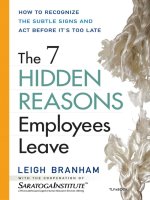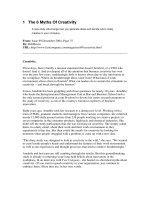Tài liệu The Definitive Book of Body Language doc
Bạn đang xem bản rút gọn của tài liệu. Xem và tải ngay bản đầy đủ của tài liệu tại đây (5.67 MB, 404 trang )
Allan and Barbara Pease are the
internationally renowned experts in
human relations and body language,
whose 20 million book sales world-
wide have turned them into household
names.
People's body language reveals that
what they say is often very different
from what they think or feel. It is a
scientific fact that people's gestures
give away their true intentions. Every
day we are confronted by hundreds
of different signals that can mean
anything from 'That's a great idea' to
'You must be kidding'. And we are all
sending out these signals whether we
realise it or not.
Now, in this authoritative guide
written with great humour and insight,
you can learn the secrets of body
language to give you more confidence
and control in any situation — from
negotiating a deal to finding the right
partner. Discover the techniques
that will show you how to interpret
gestures, read the underlying thoughts
and emotions — and reach the right
conclusions.
Front cover photo supplied courtesy of
Shufunotomo Co., Ltd. 2-9 Kanda Surugadai,
Chiyoda-Ku, Tokyo, Japan
Allan Pease is the world's foremost
expert on body language. His book
Why Men Don't Listen And Women
Can't Read Maps co-authored with
wife Barbara, has sold over 10 million
copies in 48 languages since its release.
Allan travels the world lecturing on
human communication, has written 8
other bestselling books and appeared
in his own television series which
attracted over 100 million viewers.
Barbara Pease is CEO of Pease
International which produces videos,
training courses and seminars for
business and governments world-
wide. She is also the author of the
international bestseller Why Men Lie
and Women Cry, co-authored with
husband Allan. The Authors write a
joint monthly relationship column read
by over 20 million people.
Back cover photo's supplied courtesy of
Orion Books Ltd, 5 Upper St Martins Lane,
London
The Definitive Book of
BODY LANGUAGE
ALSO BY ALLAN & BARBARA PEASE
published by Pease International
Why Men Don't Listen and
Women Can't Read Maps
Why Men Lie and Women Cry
Why Men Can Only Do One Thing at a
Time and Women Never Stop Talking
The Little Book of Men and Women
Rude and Politically Incorrect Joke Book
Talk Language
Write Language
Questions Are the Answers
The Definitive Book of
BODY LANGUAGE
Allan & Barbara Pease
PEASE INTERNATIONAL
www.peaseinternational.com
This book is dedicated to all people
who have good eyesight but who cannot see.
Published in Australia by
Pease International
PO Box 1260, Buderim
QLD4556, Australia
Tel: + 61 7 5445 5600
Fax: + 61 7 5445 5688
www.peaseinternational.com
Copyright © Allan Pease 2004
All rights reserved
The right of Allan and Barbara Pease to be identified as the
authors of this work has been asserted by them in accordance
with the Copyright, Designs and Patents Act 1988.
Printed in Australia by McPherson's Printing Group
Art direction by Santamaria www.santamaria.co.uk
Illustrations by Piero and John Hepworth
Cover design by Sarah Baron, Harper Collins Publishers Australia
www.orionbooks.co.uk
CONTENTS
Acknowledgements xiv
Introduction 1
All Things Are Not What They Seem
How Well Do You Know the Back of Your Hand?
How Well Can You Spot Body Language Contradictions?
How We Wrote This Book
Your Body Language Dictionary
1. Understanding the Basics 7
In the Beginning ...
Why It's Not What You Say
How Body Language Reveals Emotions and Thoughts
Why Women are More Perceptive
What Brain Scans Show
How Fortune-Tellers Know So Much
Inborn, Genetic or Learned Culturally?
Some Basic Origins
Universal Gestures
Three Rules for Accurate Reading
Why It Can be Easy to Misread
Why Kids are Easier to Read
Can You Fake it?
True-Life Story: The Lying Job Applicant
How to Become a Great Reader
2. The Power Is in Your Hands 31
How to Detect Openness
Intentional Use of the Palms to Deceive
The Definitive Book of Body Language
The Law of Cause and Effect Palm Power
Our Audience Experiment
An Analysis of Handshake Styles
Who Should Reach First?
How Dominance and Control Are Communicated
The Submissive Handshake
How to Create Equality
How to Create Rapport
How to Disarm a Power Player
The Cold, Clammy Handshake
Gaining the Left Side Advantage
When Men and Women Shake Hands
The Double-Hander
The Blair—Bush Power Game
The Solution
The World's Eight Worst Handshakes
The Arafat-Rabin Handshake
Summary
3. The Magic of Smiles and Laughter 66
Smiling Is a Submission Signal
Why Smiling Is Contagious
How a Smile Tricks the Brain
Practising the Fake Smile
Smugglers Smile Less
Five Common Types of Smiles
Why Laughter Is the Best Medicine
Why You Should Take Laughter Seriously
Why We Laugh and Talk, But Chimps Don't
How Humour Heals
Laughing Till You Cry
How Jokes Work
The Laughter Room
Smiles and Laughter Are a Way of Bonding
Humour Sells
The Permanent Down-Mouth
VI
Contents
Smiling Advice For Women
Laughter In Love
Summary
4. Arm Signals 90
Arm Barrier Signals
Why Crossed Arms Can be Detrimental
Yes...But I'm Just 'Comfortable'
Gender Differences
Crossed-Arms-on-Chest
Solution
Reinforced Arm-Crossing
Arm-Gripping
The Boss vs The Staff
Getting the Thumbs-Up
Hugging Yourself
How the Rich and Famous Reveal their Insecurity
The Coffee Cup Barrier
The Power of Touch
Touch their Hand Too
Summary
5. Cultural Differences 107
We Were Having Pizza at the Time
Take the Cultural Test
Why We're All Becoming American
Cultural Basics are the Same Almost Everywhere
Greeting Differences
When One Culture Encounters Another
The English Stiff-Upper-Lip
The Japanese
'You Dirty, Disgusting Pig!' - Nose Blowing
The Three Most Common Cross-Cultural Gestures
To Touch or Not to Touch?
How to Offend Other Cultures
Summary
VII
The Definitive Book of Body Language
6. Hand and Thumb Gestures 125
How the Hands Talk
On the One Hand...
On the Other Hand, Gestures Improve Recall
Rubbing the Palms Together
Thumb and Finger Rub
Hands Clenched Together
The Steeple
Summary
The Face Platter
Holding Hands Behind the Back
Thumb Displays
Thumbs-Protruding-from-Coat-Pocket
Summary
7. Evaluation and Deceit Signals 142
Lying Research
The Three Wise Monkeys
How the Face Reveals the Truth
Women Lie the Best and That's the Truth
Why It's Hard to Lie
Eight of the Most Common Lying Gestures
Evaluation and Procrastination Gestures
The Lying Interviewee
Chin Stroking
Stalling Clusters
Head Rubbing and Slapping Gestures
Why Bob Always Lost at Chess
The Double Meaning
8. Eye Signals 165
The Dilating Pupils
Take the Pupil Test
Women Are Better at It, as Usual
Giving Them the Eye
The Eyebrow Flash
VIII
Contents
Eye Widening
The 'Looking Up' Cluster
How Men's Fires Get Lit
Gaze Behaviour - Where Do You Look?
How to Keep Eye Contact in a Nudist Colony
How to Grab a Man's Attention
Most Liars Look You in the Eye
How to Avoid being Attacked or Abused
The Sideways Glance
Extended Blinking
Darting Eyes
The Geography of the Face
The Politician's Story
Look Deep Into My Eyes, Baby
The First 20 Seconds of an Interview
What Channel Are You Tuned to?
How to Hold Eye Contact with an Audience
How to Present Visual Information
The Power Lift
Summary
9. Space Invaders - Territories and Personal Space 192
Personal Space
Zone Distances
Practical Applications of Zone Distances
Who Is Moving In on Whom?
Why We Hate Riding in Lifts
Why Mobs Become Angry
Spacing Rituals
Try the Luncheon Test
Cultural Factors Affecting Zone Distances
Why Japanese Always Lead When They Waltz
Country vs. City Spatial Zones
Territory and Ownership
Car Territory
Take the Test
Summary
IX
The Definitive Book of Body Language
10. How the Legs Reveal What the Mind Wants to Do 209
Everybody's Talking About a New Way of Walking
How Feet Tell the Truth
The Purpose of the Legs
The Four Main Standing Positions
Defensive, Cold or 'Just Comfortable'?
How We Move from Closed to Open
The European Leg Cross
The American Figure Four
When the Body Closes, so Does the Mind
Figure Four Leg Clamp
The Ankle Lock
The Short Skirt Syndrome
The Leg Twine
Parallel-Legs
Put Your Right Foot In, Put Your Right Foot Out
Summary
11. The 13 Most Common Gestures You'll See Daily 229
The Head Nod
Why You Should Learn to Nod
How to Encourage Agreement
The Head Shake
The Basic Head Positions
The Head Shrug
Picking Imaginary Lint
How We Show We're Ready for Action
The Cowboy Stance
Sizing Up the Competition
The Legs-Spread
Leg-Over-the-Arm-of-Chair
Straddling a Chair
The Catapult
Gestures That Show When a Person is Ready
The Starter's Position
Summary
Contents
12. Mirroring - How We Build Rapport 250
Creating the Right Vibes
Mirroring on a Cellular Level
Mirroring Differences Between Men and Women
What to Do About It if You're Female
When Men and Women Start to Look Alike
Do We Resemble Our Pets?
Monkey See, Monkey Do
Matching Voices
Intentionally Creating Rapport
Who Mirrors Whom?
Summary
13. The Secret Signals of Cigarettes, Glasses and Make-up 265
The Two Types of Smokers
Differences Between Men and Women
Smoking as a Sexual Display
How to Spot a Positive or Negative Decision
Cigar Smokers
How Smokers End a Session
How to Read Glasses
Stalling Tactics
Peering-Over-the-Glasses
Wearing Glasses on the Head
The Power of Glasses and Make-up
A Little Lippy, Lady?
Briefcase Signals
Summary
14. How the Body Points to Where the Mind Wants to Go 279
What Body Angles Say
How We Exclude Others
Seated Body Pointing
Foot Pointing
Summary
XI
The Definitive Book of Body Language
15. Courtship Displays and Attraction Gestures 286
The Emergence of the Colourful Male
Graham's Story
Why Women Always Call the Shots
Differences Between Men and Women
The Attraction Process
The 13 Most Common Female Courtship Gestures and
Signals
How Beautiful People Miss Out
What Men Look At in Women's Bodies
Is He a Bum, Boobs or Leg Man?
Male Courtship Signals and Gestures
Men's Bodies - What Turns Women On the Most
Is She a Chest, Legs or Bum Gal?
Summary
16. Ownership, Territory and Height Signals 317
Body Lowering and Status
He's a Big Man Around Town
Why Some People Seem Taller on TV
Try the Floor Test
Body Lowering and Status
He's a Big Man Around Town
, Why Some People Seem Taller on TV
Try the Floor Test
The Downsides of Height
How Body Lowering Can Sometimes Raise Status
How TV Politicians Can Win Votes
How to Placate Angry People
What's Love Got To Do With It?
Some Strategies For Gaining Perceived Height
Summary
17. Seating Arrangements - Where to Sit and Why 330
Take the Table Test
It's Not What You Say, It's Where You Sit
XII
Contents
King Arthur's Concept
Keeping Two People Involved
Rectangular Board Tables
Why Teacher's Pet Sits On the Left
Power Plays at Home
How to Make an Audience Cry
The Attention Zone
An Experiment in Learning
Getting a Decision Over Dinner
Summary
18. Interviews, Power Plays and Office Politics 346
Why James Bond Looked Cool, Calm and Collected
The Nine Golden Keys to Making Great First Impressions
When Someone Keeps You Waiting
Fake It Till You Make It?
Seven Simple Strategies for Giving You the Extra Edge
Summary
Office Power Politics
How to Switch Table Territories
Seated Body Pointing
How to Re-arrange an Office
Summary
19. Putting It All Together 364
How Well Can You Read Between the Lines?
How Did You Rate?
Summary
The Six Secrets of Attractive Body Language
References 380
XIII
ACKNOWLEDGEMENTS
These are some of the people who have directly or indirectly contributed
to this book, whether they knew it or not:
Dr John Tickel, Dr Dennis Waitley, Dr Andre Davril, Professor Phillip
Hunsaker, Trevor Dolby, Armin Gontermann, Lothar Menne, Ray &
Ruth Pease, Malcolm Edwards, Ian Marshall, Laura Meehan, Ron 6c
Toby Hale, Darryl Whitby, Susan Lamb, Sadaaki Hayashsi, Deb
Mehrtens, Deb Hinckesman, Doreen Carroll, Steve Wright, Derryn
Hinch, Dana Reeves, Ronnie Corbett, Vanessa Feltz, Esther Rantzen,
Jonathan Coleman, Trish Goddard, Kerri-Anne Kennerley, Bert Newton,
Roger Moore, Lenny Henry, Ray Martin, Mike Walsh, Don Lane, Ian
Lesley, Anne Diamond, Gerry & Sherry Meadows, Stan Zermarnik,
Darrel Somers, Andres Kepes, Leon Byner, Bob Geldof, Vladimir Putin,
Andy McNab, John Howard, Nick & Katherine Greiner, Bryce Court-
ney, Tony & Cherie Blair, Greg & Kathy Owen, Lindy Chamberlain,
Mike Stoller, Gerry & Kathy Bradbeer, Ty & Patti Boyd, Mark Victor
Hansen, Brian Tracy, Kerry Packer, Ian Botham, Helen Richards, Tony
Greig, Simon Townsend, Diana Spencer, Princes William and Harry,
Prince Charles, Dr Desmond Morris, Princess Anne, David & Jan
Goodwin, Iven Frangi, Victoria Singer, John Nevin, Richard Otton,
Raoul Boielle, Matthew Braund, Doug Constable, George Deveraux,
Rob Edmonds, Gerry Hatton, John Hepworth, Bob Heussler, Gay
Huber, Ian McKillop, Delia Mills, Pamela Anderson, Wayne Mugridge,
Peter Opie, David Rose, Alan White, Rob Winch, Ron Tacchi, Barry
Markoff, Christine Maher, Sallie & Geoff Burch, John Fenton, Norman
& Glenda Leonard
and
Dorie Simmonds, whose encouragement and enthusiasm
drove us to write this book.
Introduction
By a man's fingernails, by his coat-sleeve, by his boots,
by his trouser-knees, by the calluses of his forefinger and
thumb, by his expression, by his shirt-cuffs, by his move-
ments - by each of these things a man's calling is plainly
revealed. That all united should fail to enlighten the com-
petent enquirer in any case is almost inconceivable.
SHERLOCK HOLMES, 1892
As a young boy, I was always aware that what people said was
not always what they meant or were feeling and that it was
possible to get others to do what I wanted if I read their real
feelings and responded appropriately to their needs. At the age
of eleven, I began my sales career selling rubber sponges door-
to-door after school to make pocket money and quickly
worked out how to tell if someone was likely to buy from me
or not. When I knocked on a door, if someone told me to go
away but their hands were open and they showed their palms,
I knew it was safe to persist with my presentation because,
despite how dismissive they may have sounded, they weren't
aggressive. If someone told me to go away in a soft voice but
used a pointed finger or closed hand, I knew it was time to
leave. I loved being a salesperson and was excellent at it. As a
teenager, I became a pots and pans salesperson, selling at
night, and my ability to read people earnt me enough money
to buy my first piece of property. Selling gave me the opportu-
nity to meet people and study them at close range and to
evaluate whether they would buy or not, simply by watching
their body language. This skill also proved a bonanza for
meeting girls in discos. I could nearly always predict who
would say 'yes' to a dance with me and who wouldn't.
The Definitive Book of Body Language
I joined the life insurance business at the age of twenty, and
went on to break several sales records for the firm I worked for,
becoming the youngest person to sell over a million dollars'
worth of business in my first year. This achievement qualified
me for the prestigious Million Dollar Round Table in the USA.
As a young man I was fortunate that the techniques I'd learned
as a boy in reading body language while selling pots and pans
could be transferred to this new area, and was directly related
to the success I could have in any venture involving people.
All Things Are Not What They Seem
The ability to work out what is really happening with a person
is simple - not easy, but simple. It's about matching what you
see and hear in the environment in which it all happens and
drawing probable conclusions. Most people, however, only see
the things they think they are seeing.
Here's a story to demonstrate the point:
Two men were walking through the woods when they came
across a big deep hole.
'Wow ... that looks deep,' says one. 'Let's toss a few pebbles
in and see how deep it is.'
They threw in a few pebbles and waited, but there was no
sound.
'Gee - that is a really deep hole. Let's throw one of these
big rocks in. That should make a noise.'
They picked up two football-sized rocks and tossed them
into the hole and waited, but still they heard nothing.
'There's a railway sleeper over here in the weeds,' said one.
'If we toss that in, it's definitely going to make some noise.'
They dragged the heavy sleeper over to the hole and heaved it
in, but not a sound came from the hole.
Suddenly, out of the nearby woods, a goat appeared,
running like the wind. It rushed towards the two men and ran
right between them, running as fast as its legs could go. Then
Introduction
it leaped into the air and disappeared into the hole. The two
men stood there, astonished at what they'd just seen.
Out of the woods came a farmer who said, 'Hey! Did you
guys see my goat?'
'You bet we did! It was the craziest thing we've ever seen! It
came running like the wind out of the woods and jumped
into that hole!'
'Nah,' says the farmer. 'That couldn't have been my goat.
My goat was chained to a railway sleeper!'
How Well Do You Know the Back
of Your Hand?
Sometimes we say we know something 'like the back of our
hand' but experiments prove that less than 5% of people can
identify the back of their hands from a photograph. The
results of a simple experiment we conducted for a television
programme showed that most people are generally not good at
reading body language signals either. We set up a large mirror
at the end of a long hotel lobby, giving the illusion that, as you
entered the hotel, there was a long corridor going through the
hotel and out the back of the lobby. We hung large plants from
the ceiling to a distance of 5 feet above the floor so that, as
each person entered the lobby, it looked as if another person
was entering at the same time from the other end. The 'other
person' was not readily recognisable because the plants
covered their face, but you could clearly see their body and
movement. Each guest observed the other 'guest' for five to six
seconds before turning left to the reception desk. When asked
if they had recognised the other 'guest', 85% of men answered
no'. Most men had failed to recognise themselves in a mirror,
one saying, 'You mean that fat, ugly guy?' Unsurprisingly, 58%
of the women said it was a mirror and 30% said the other
'guest' looked 'familiar'.
The Definitive Book of Body Language
Most men and nearly half of all women
don't know what they look like from the neck down.
How Well Can You Spot Body Language
Contradictions?
People everywhere have developed a fascination with the body
language of politicians because everyone knows that politi-
cians sometimes pretend to believe in something that they
don't believe in, or infer that they are someone other than who
they really are. Politicians spend much of their time ducking,
dodging, avoiding, pretending, lying, hiding their emotions
and feelings, using smokescreens or mirrors and waving to
imaginary friends in the crowd. But we instinctively know that
they will eventually be tripped up by contradictory body lan-
guage signals, so we love to watch them closely, in anticipation
of catching them out.
What signal alerts you that a politician is lying?
His lips are moving.
For another television show, we conducted an experiment with
the co-operation of a local tourist bureau. Tourists entered the
bureau to ask for information about local sightseeing and
other tourist attractions. They were directed to a counter
where they spoke with a tourism officer, a man with blond
hair, a moustache, wearing a white shirt and tie. After a few
minutes discussing possible itineraries, the man bent down out
of sight below the counter to get some brochures. Then,
another man with a clean-shaven face, dark hair and wearing
a blue shirt appeared from beneath the counter holding the
brochures. He continued the discussion from exactly where the
first man had left off. Remarkably, around half the tourists
failed to notice the change and men were twice as likely as
Introduction
women to completely miss the change, not only in body lan-
guage but in the appearance of a completely new person!
Unless you have an innate ability or have learned to read body
language, the chances are you're missing most of it too. This
book will show you what you've been missing.
How We Wrote This Book
Barbara and I have written The Definitive Book of Body Lan-
guage using my original book, Body Language, as our base.
Not only have we considerably expanded on that one, we have
also introduced research from new scientific disciplines, such
as evolutionary biology and evolutionary psychology as well
as technologies such as Magnetic Resonance Imaging (MRI),
which shows what happens in the brain. We have written it in
a style that means it can be opened and read on almost any
page at random. We've kept the content mainly to the move-
ment of the body, expressions and gestures, because these are
the things you need to learn to get the most out of every face-
to-face encounter. The Definitive Book of Body Language will
make you more aware of your own non-verbal cues and
signals, and will show you how to use them to communicate
effectively and how to get the reactions you want.
This book isolates and examines each component of body
language and gesture in simple terms to make it accessible to
you. Few gestures are made in isolation of others however, so
we have also, at the same time, tried to avoid oversimplifying
things.
There will always be those who throw up their hands in
horror and claim that the study of body language is just
another means by which scientific knowledge can be used to
exploit or dominate others by reading their secrets or
thoughts. We feel however, that this book seeks to give you
greater insight into communication with your fellow humans,
so that you can have a deeper understanding of other people
and, therefore, of yourself. Understanding how something
The Definitive Book of Body Language
works makes living with it easier, whereas ignorance and lack
of understanding promote fear and superstition and make us
more critical of others. A birdwatcher doesn't study birds so
that he can shoot them down and keep them as trophies. In the
same way, the knowledge and skills in body language serve to
make every encounter with another person an exciting experi-
ence.
For the purpose of simplicity, and unless otherwise stated,
the use of 'he' or 'him' will apply equally to both genders.
Your Body Language Dictionary
The original book was intended as a working manual for sales
people, managers, negotiators and executives, but this one can
be used for any aspect of your life, be it at home, on a date or
at work. The Definitive Book of Body Language is the result
of over 30 years of our cumulative knowledge and involvement
in this field and we give you the basic 'vocabulary' you need to
read attitudes and emotions. This book will give you answers
to some of the most puzzling questions you've ever had about
why people use some of the behaviours they do, and it will
change forever your own behaviour. It will seem as if you've
always been in a dark room and, while you could always feel
the furnishings, the wall hangings and the door, you've never
actually seen what they look like. This book will be like
turning on the lights to see what was always there. But now,
you'll know exactly what things are, where they are and what
to do about them.
Allan Pease
Chapter 1
UNDERSTANDING
THE BASICS
This is 'good' to Westerners, 'one' to Italians,
'five' to Japanese and 'up yours' to the Greeks
Everyone knows someone who can walk into a room full of
people and, within minutes, give an accurate description about
the relationships between those people and what they are
feeling. The ability to read a person's attitudes and thoughts
by their behaviour was the original communication system
used by humans before spoken language evolved.
Before radio was invented, most communication was done
in writing through books, letters and newspapers, which
meant that ugly politicians and poor speakers, such as
Abraham Lincoln, could be successful if they persisted long
enough and wrote good print copy. The radio era gave open-
ings to people who had a good command of the spoken word,
like Winston Churchill, who spoke wonderfully but may have
struggled to achieve as much in today's more visual era.









